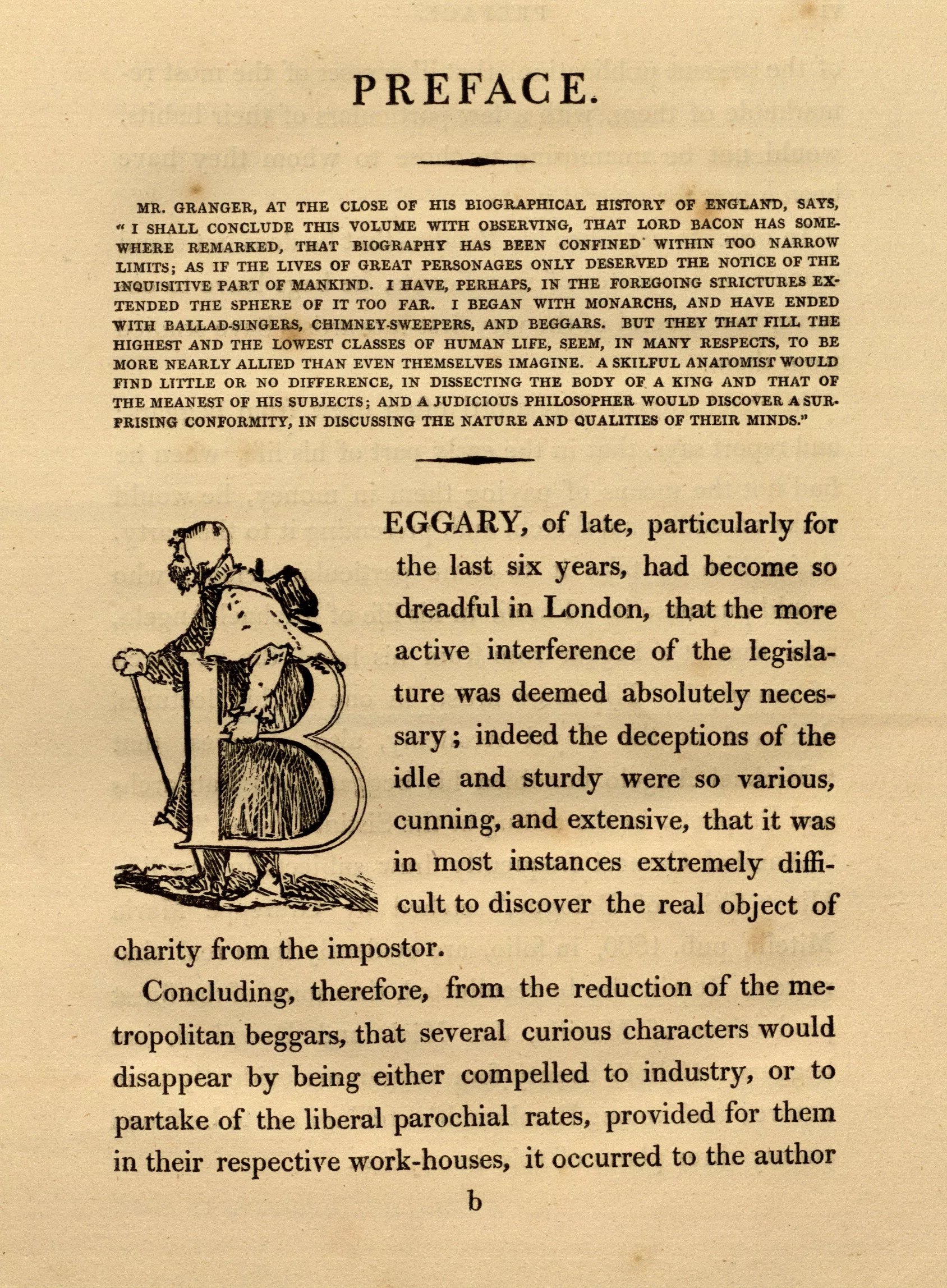Exhibit
Creation Date
1817
Height
6 cm
Width
4 cm
Medium
Genre
Description
This image features text which, like an illuminated manuscript, begins with a decorated letter. The "B" of the text is carried by a beggar, consequently giving a visual synecdoche of the written topic, "beggary."
A man in a long cape and cloth cap holds a cane in his right hand and a large letter “B” in his left as he walks. He has a beard and moustache, and a rimmed black hat hangs from his neck.
The historiated initial beginning the text featured in this image provides the first letter in the word “Beggary.” Historiated initials are enlarged letters that are decorated or occupied by figures of humans, animals, foliage, etc. These embellishments may be simply ornamental, or (as in the case of Vagabondiana) they may have a narrative or symbolic purpose. Here, the human figure reiterates the theme of the text and illustrates the meaning of the word it helps to articulate.
In contrast to inhabited or figured initials, historiated initials maintain a distinction between the form of the letter and its embellishment. Typically, the decorative figure or scene is “narrated within or germane to the text” that it introduces (Calkins). The conceit that the initial is a three-dimensional object being carried by the superfluous figure is comparatively rare; however, two types of exceptions can be found within medieval manuscripts and merit consideration. First, there are initials in which mischievous characters appear to “carry off” the letter in question, as seen in the opening “Q” of Virgil’s Georgics, Book I (MS London, British Library, King’s 24, fol. 17). Here, the “Q” is carried by two roguish satyrs as a third rides astride the consonant. Second, there are initials that present the letter as a physical burden, as with the “T” in the Homiliary of Le Cateau (Bibliotheque Municipale, MS 528, fol. 195). Here, the Emperor Heraclius is shown struggling under the weight of the True Cross (which also functions as the letter “T”) on his way to Jerusalem (Alexander 18). The beggar of our prefatory “B” is likewise both hampered and mischievous. As a wanderer, he must bear the burden of his portable possessions, while as a beggar he is believed to be inclined towards theft.
The historiated initials that pepper Smith’s Vagabondiana seem worth highlighting as they propose a specific relationship between movement, literacy, and commodity. The printed word and the books which collect, contain and distribute language in its written form allow language to be bought, sold and owned as a material object. As commodities operating within an economy based on personal property, texts are thus subject to theft, vandalism, and misuse. The man that both personifies beggary and entwines his body with the inauguratory letter of the word that seeks to classify him seems also to execute the action for which the beggar is best known—he picks up the letter and moves on as if to take the letter from the page. Elsewhere in the text we find figures vandalizing and molesting letters as if they are pieces of property, which can likewise be picked up and carried off.
Collection
Accession Number
Thordarson T 4263
Additional Information
Bibliography
Alexander, J.J.G.. The Decorated Letter. New York: Braziller, 1978. Print.
Calkins, Robert. "Initial, manuscript." Grove Art Online. Oxford Art Online. Oxford UP, 9 July 2012. Web. 6 May. 2009.
Smith, John Thomas. Vagabondiana, or, Anecdontes of Mendicant Wanderers Through the Streets of London. London: A. Arch, 1817. Print.

